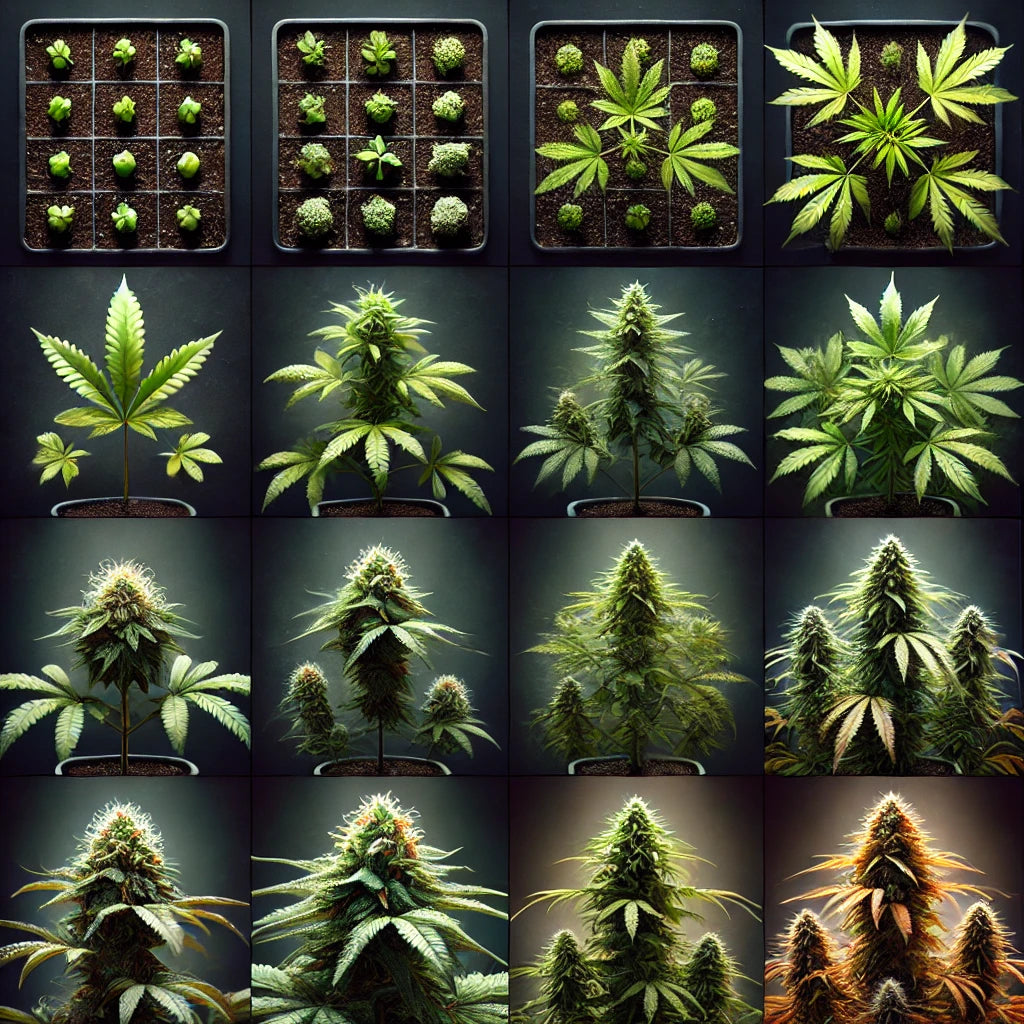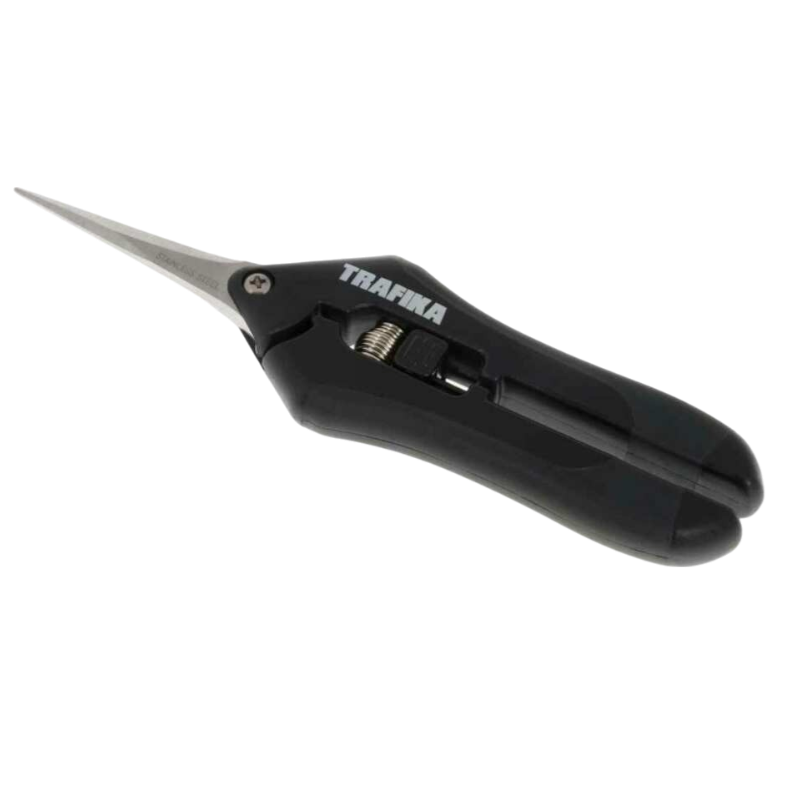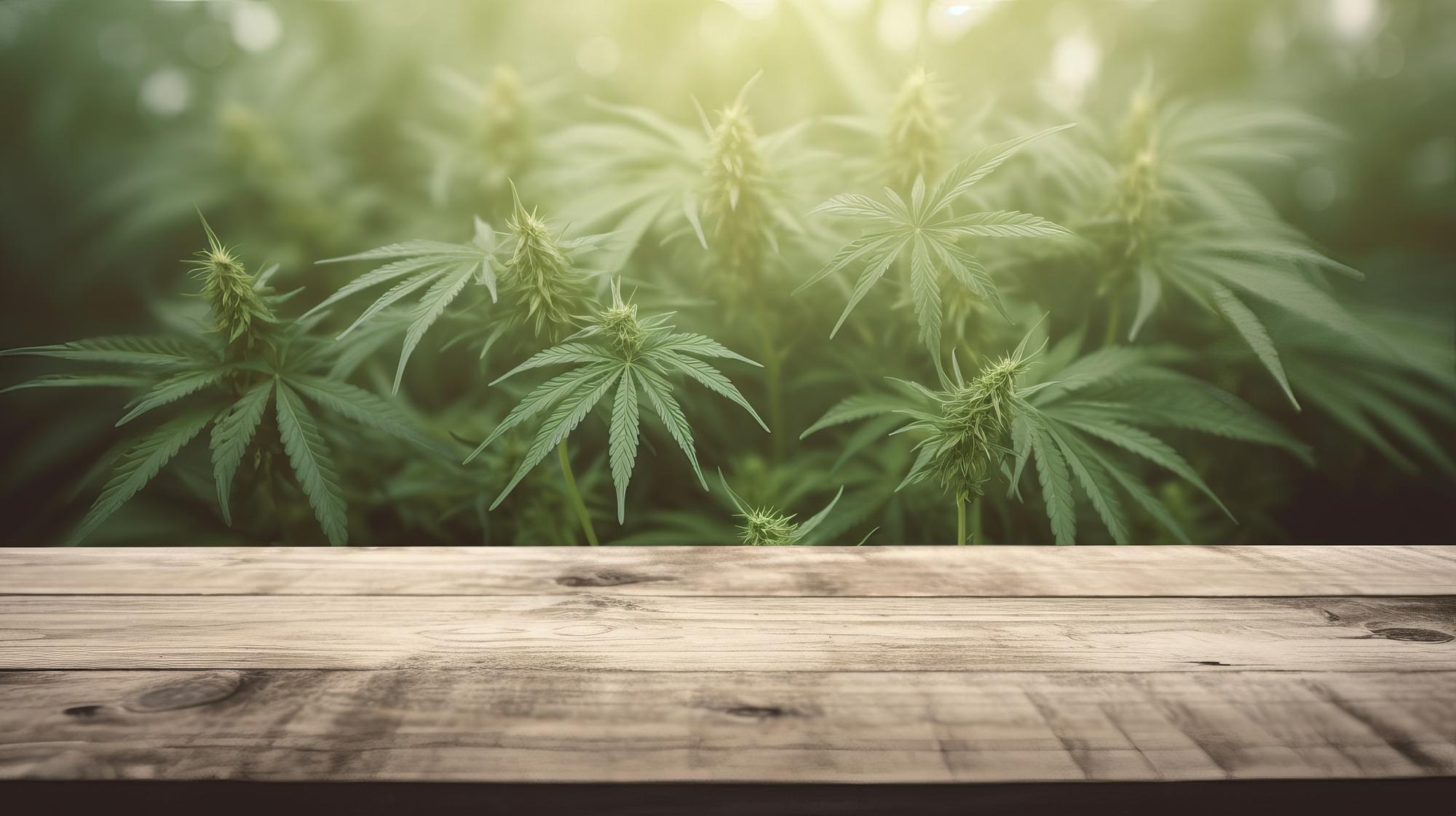1. Quick start: Checklist for germinating cannabis seeds
1.1 Necessary materials
To successfully germinate cannabis seeds, you first need the basic materials. These include:
- High quality cannabis seeds
- A container for germination (depending on the method: water glass, damp kitchen paper, growing plugs, rock wool blocks)
- Water (preferably stale or filtered)
- A heat source (optional, depending on the ambient temperature)
- A bright but not directly sunny place
1.2 Short checklist of steps
Follow this quick checklist to ensure successful germination:
- Seed selection : Choose seeds that look healthy and ripe – dark and without cracks.
- Preparation : Choose the germination method and prepare all materials.
- Environmental conditions : Make sure the temperature is between 22 and 25°C and the seeds are kept constantly moist but not wet.
- Monitoring : Monitor seeds daily to ensure conditions remain optimal.
- Care of seedlings : Once the seeds germinate, provide adequate light and proper watering to strengthen the young plants.
2. Introduction: The importance of the germination phase
The germination phase is the critical first step in a cannabis plant's life cycle and lays the foundation for healthy growth and bountiful harvests. This phase encompasses the process in which a dormant seed comes to life and begins to develop its first root and shoot. The ability to successfully germinate cannabis seeds is essential for any grower as it directly affects the quality and vitality of the future plant.
The importance of this phase cannot be overstated. Successful germination not only ensures the start of the growth cycle, but also optimizes the genetic potential of the plant, resulting in greater resistance to pests and diseases, better nutrient uptake, and ultimately more lush flowers. Therefore, it is essential to approach the germination process with care, precision, and a deep understanding of the needs of the cannabis seeds.
2.1 Importance of germination
Germination is the very first step in the life of a cannabis plant and is crucial to the success of the entire cultivation project. During this phase, the cannabis seed awakens from its dormant state when the right conditions - moisture, warmth and in some cases light - are present. This process initiates the development of the root, which expands downwards, and the shoot, which extends upwards and eventually breaks through the soil surface.
The importance of this initial phase cannot be overstated. It sets the tone for the health and performance of the plant throughout its life cycle. Successful germination results in a strong start that allows the young plant to develop maximum strength and resilience. Failures or mistakes in this early phase can result in delayed growth, weaker plants and, in the worst case, death of the seedling. Therefore, it is essential for growers to treat the germination process with the utmost attention and care.
2.2 Overview of the process
The germination process begins once the cannabis seed is placed in a moist environment that signals that conditions are favorable for growth. During this phase, the seed absorbs water, swells, and eventually breaks open the seed coat. This allows the embryonic root (radicle) to stretch downward while the shoot (hypocotyl) grows upward to reach the light. This process is aided by the right balance of moisture, heat, and air circulation, which are essential for germination.
The length of time it takes for germination to take place can vary, but typically it takes between 24 hours and a week for the first signs of germination to appear. During this time, it is of utmost importance not to disturb the seeds and to keep conditions consistent. Once the sprout breaks the surface, the next phase of the cannabis life cycle begins - the seedling phase.
It is important to understand that the success of germination depends greatly on the quality of the seeds and the accuracy in maintaining the required conditions. Careful monitoring and care during this sensitive period can lay the foundation for a successful harvest.
3. Selection of cannabis seeds
Choosing the right cannabis seeds is a crucial step that will significantly affect the entire growing cycle and the final product. With so many strains and types of cannabis seeds available, deciding which seeds are best suited to individual needs and growing environments can be challenging. There are several key factors to consider when making a selection, including the genetics of the plant, growing conditions, and the desired effect of the final product.
The basic types of cannabis seeds - feminized, autoflowering and CBD-rich - offer different benefits and are suited to different growing goals. Feminized seeds develop into flower-producing female plants, making them ideal for cannabis flower producers. Autoflowering seeds require less care and go through their life cycle more quickly, making them a good choice for beginners or for growing in cooler climates. CBD-rich seeds, on the other hand, are designed to have high CBD levels and low THC levels, ideal for medical users seeking the therapeutic benefits of cannabis without strong psychoactive effects.
Choosing the right seeds is the first step to success. An informed choice allows growers to use their resources efficiently and achieve the results they want. This section will dive deeper into the criteria for choosing cannabis seeds and offer practical advice to help growers make the best choices for their specific needs.
3.1 Criteria for high-quality seeds
When choosing cannabis seeds, quality is crucial for the subsequent success of the cultivation. High-quality seeds are the basic requirement for healthy plants and abundant harvests. There are several key indicators that growers should consider to assess the quality of seeds:
- External appearance : Good seeds have a smooth, undamaged surface and are usually dark brown. Lighter or greenish seeds are often immature and have a lower germination rate.
- Size and shape : High-quality seeds have a uniform, symmetrical shape and are neither too small nor stunted, indicating good genetics and maturity.
- Hardness and durability : If you squeeze a seed lightly between your fingers, it should be firm and durable. Soft or brittle seeds are often of poor quality.
- Odor : While seeds generally do not have a strong odor, they should be fresh and not have a musty or other unpleasant odor that could indicate mold or spoilage.
- Origin and reputation of the seed bank : Choosing a recognized and trustworthy seed bank usually guarantees the quality and accuracy of the seed genetics. Reviews and experiences of other growers can help to assess the reliability of a supplier.
By applying these criteria when selecting their seeds, growers can greatly increase the likelihood of successful germination and vigorous plant growth. It is also advisable to research the specific needs and requirements of the chosen cannabis strain before purchasing to ensure that it is compatible with the given growing conditions.
3.2 Differences between seed types
Choosing the right type of cannabis seeds is crucial to meeting individual growing goals. Generally speaking, cannabis seeds fall into three main categories: feminized, autoflowering, and CBD-rich seeds. Each of these seed types brings with it specific characteristics that make them suitable for different growing conditions and uses.
- Feminized seeds : These seeds are genetically modified to produce almost exclusively female plants. Female cannabis plants are those that produce cannabis flowers. For growers interested in growing flowers, feminized seeds offer the advantage of not having to worry about male plants that could contaminate the flower stocks with pollen.
- Autoflowering seeds : Autoflowering cannabis seeds are characterized by the fact that they enter the flowering phase regardless of the light conditions. These seeds are ideal for growers who grow in regions with less than ideal light conditions or who want to achieve multiple harvests per season. In addition, autoflowering strains are often more robust and easier to grow.
- CBD-Rich Seeds : These seeds are specifically bred to have high CBD content and low THC content, making them particularly suitable for medicinal users who want to enjoy the therapeutic benefits of cannabis without the psychoactive effects of THC.
The decision as to which type of seed to choose depends on personal preference, specific growing conditions and the desired end product. It is advisable to do extensive research before purchasing and consider the experiences of other growers if necessary in order to make the best possible decision for your own cultivation.
4. Create optimal conditions
Creating optimal conditions for cannabis seeds to germinate is a crucial step in laying the foundation for a successful harvest. The germination phase is particularly sensitive, and the young seeds require a precise balance of moisture, heat and light to germinate and grow healthily. This section focuses on the key factors that growers need to control in order to create an ideal environment for their cannabis seeds to germinate.
Temperature plays a crucial role in the germination process, with temperatures that are too high or too low delaying or even preventing germination. Humidity is also crucial, as cannabis seeds need sufficient water to initiate the germination process without being exposed to the risk of mold or rot due to overwatering. Light is another important factor that can promote or inhibit germination, depending on the type of seed. Creating adequate air exchange is also essential to prevent mold growth and support healthy root development.
By carefully managing these conditions, growers can increase the likelihood of successful germination and create a strong foundation for continued cannabis plant growth. The following sections provide detailed insights and practical tips on how to achieve this optimal environment for cannabis seed germination.
4.1 Importance of temperature
Finding the right temperature is crucial for germinating cannabis seeds. A consistent temperature in the range of 22 to 25°C is considered ideal for most cannabis strains. This temperature range allows the seeds to absorb the energy necessary to begin the germination process. Temperatures significantly below or above this range can significantly delay the germination process, reduce the germination rate, or even damage the seeds.
Conditions that are too cold slow down the enzymatic activities within the seed, resulting in a longer germination time. In the worst case, the seeds may not germinate at all. On the other hand, temperatures that are too high can damage the delicate embryonic structures in the seed, thus affecting the vitality of the future plant.
Growers germinating in cooler climates or during colder seasons should consider additional heat sources, such as heat mats specifically designed for horticulture. In warmer climates or environments, it is important to keep seeds cool to avoid overheating. Regardless of location, it is advisable to continually monitor the temperature and make adjustments as needed to maintain ideal conditions.
Investing in a reliable thermometer or thermohygrometer that measures both temperature and humidity can be a valuable aid in optimizing the environment during the germination phase.
4.2 Importance of moisture and light
Humidity and light are two other essential factors that affect the germination of cannabis seeds. An appropriate moisture balance is crucial to support the germination process without exposing the seeds to the risk of mold or rot. At the same time, depending on the germination method and cannabis strain, light plays a variable role in the early stages of plant growth.
Humidity: Cannabis seeds require consistent humidity to initiate germination. This does not mean that the seeds should be soaked in water, but that the surrounding medium (such as damp kitchen paper towels, soil or rockwool) must be kept evenly moist. A relative humidity (RH) of 70-90% is considered ideal for the germination phase. Humidity levels that are too low can cause the seeds to dry out and not germinate, while levels that are too high can encourage mold growth.
Light: The need for light during germination can vary depending on the type of seed. While some seeds can germinate in the dark, other varieties require light, indirect light to encourage the germination process. However, once the seeds have germinated and the seedlings are developing, light becomes essential for photosynthesis and healthy growth of the young plants. During this stage, seedlings should receive 14-18 hours of light per day to encourage vigorous development.
It is important to carefully monitor and adjust humidity and light conditions during germination. Using special germination stations or chambers can help control these conditions and ensure successful germination.
4.3 The ideal germination location
Choosing the ideal location for germinating cannabis seeds is another crucial factor that influences the success of this sensitive phase. An optimal germination location combines the right temperature, humidity and light conditions while protecting the seeds from external disturbances and contamination. Here are some important aspects to consider when choosing the germination location:
- Quiet environment: Choose a location that is protected from direct disturbances and strong vibrations. Excessive movement or vibrations can disrupt the delicate germination processes.
- Consistent environmental conditions: The location should be able to maintain consistent temperature and humidity levels. Fluctuations in these conditions can affect the germination rate.
- Adequate light: Make sure the site has access to adequate light, whether natural light for those seeds that need it or artificial light that can be used after germination to support the young seedlings.
- Protection from pests: The germination site should be chosen so that it offers a low risk of pest contamination. Pests can easily damage or destroy young seedlings.
Some growers prefer to use special germination devices or chambers that allow precise control of all the necessary environmental variables. Alternatively, a carefully selected area in the house or greenhouse that meets these criteria can also be a suitable germination location. Regardless of the method chosen, it is crucial to regularly monitor and adjust the environment to ensure it remains optimal for germination.
5. Methods for germinating cannabis seeds
Germination is the first step towards a successful cannabis grow. Various methods can be used to initiate this process, each offering its own advantages and disadvantages. Choosing the right germination method depends on the individual preference of the grower, the resources available, and the specific requirements of the cannabis strain. This section will cover the most common methods of germinating cannabis seeds, including sowing directly into soil, the water glass method, the paper towel method, and using grow plugs and rockwool blocks. The goal is to give growers a solid understanding of each method and help them choose the method that best suits their situation.
Regardless of the method chosen, it is important to ensure the basic conditions for successful germination - adequate humidity, optimal temperature and, if necessary, the right light. Careful planning and preparation can increase the germination rate and lay the foundation for the growth of healthy and vigorous cannabis plants.
5.1 Direct sowing into the soil
Sowing directly into soil is one of the most natural methods of germinating cannabis seeds and is often appreciated for its simplicity and effectiveness. This method mimics the natural process of seeds germinating in their natural environment, without prior contact with water or other germination media.
Advantages:
- Minimizes the risk of transplant shock because the seeds are grown from the beginning in the medium in which they will develop.
- Simplicity of the method, which does not require any special materials or pretreatments.
- Provides a stable environment that simulates natural germination conditions.
Disadvantages:
- Monitoring moisture and temperature conditions can be more challenging because the seeds are hidden beneath the soil surface.
- There is a higher risk of planting the seeds too deep, which can make germination difficult.
How to do it: Choose a high-quality growing medium and moisten it slightly before planting the seeds to a depth of about 1-2 cm. Mark the spot where each seed was planted and keep the medium consistently moist but not wet to create the best germination conditions. The ideal temperature should be between 22 and 25°C. With patience and careful care, the seeds should germinate within a week.
This method is particularly suitable for growers who prefer the most natural cultivation method possible and want to have direct control over the initial conditions of their plants.
5.2 The water glass method
The glass of water method is a popular technique for germinating cannabis seeds, appreciated for its simplicity and high success rate. This method involves placing the seeds in a glass of water, which stimulates the germination process.
Advantages:
- Allows easy monitoring of the seed swelling process.
- High germination rate due to constant moisture supply.
- Easy to perform and requires no special tools or equipment.
Disadvantages:
- If seeds are exposed to water for too long, they may drown or become susceptible to mold growth.
- Requires careful transfer of germinated seeds into the growing medium to avoid damage.
Procedure: Fill a clean glass with lukewarm water (approx. 22 to 25°C) and place the cannabis seeds in it. Leave the seeds in the water for 12 to 24 hours, with the glass in a dark place. After this time, the seeds should begin to swell and possibly crack their shells. As soon as the first roots are visible, the seeds should be carefully transferred to the growing medium of your choice.
This method is particularly suitable for growers who want to closely monitor the germination process and achieve quick results.
5.3 The paper towel method
The paper towel method is another widely used technique for germinating cannabis seeds, which scores points for its simplicity and the ability to closely observe the germination process.
Advantages:
- Allows precise control and observation of moisture during germination.
- Easy to implement with everyday materials.
- High success rate when performed correctly.
Disadvantages:
- Handling the germinated seeds requires care so as not to damage the delicate roots.
- A constant level of moisture must be ensured without the seeds becoming soaked.
How to do it: Place a damp but not soaking paper towel on a plate. Spread the cannabis seeds out on the paper towel, leaving some space between them, and cover them with another damp paper towel. To retain moisture and create a microclimate, a second plate can be used as a lid. Store the seeds in a warm place (22 to 25°C) and in the dark. Check the seeds daily and make sure the paper towel stays damp. The seeds should germinate within 24 to 72 hours.
This method is ideal for growers who want to closely monitor the germination process while ensuring that the seeds receive the perfect amount of moisture.
5.4 Use of cultivation plugs and rockwool blocks
Using propagation plugs and rockwool blocks is an efficient method of germinating cannabis seeds, especially for growers who value precision and control in the germination process.
Advantages:
- Facilitates even moisture distribution and provides an optimal environment for germination.
- Reduces the risk of mold growth through controlled water absorption.
- Allows easy transfer of seedlings to the final growing medium without much stress to the young plant.
Disadvantages:
- The purchase costs for propagation plugs and rockwool blocks can be higher than for simpler methods.
- Requires a certain level of prior knowledge and experience for optimal use.
How to do it: Moisten the propagation plugs or rockwool blocks according to the manufacturer's instructions. Place the cannabis seeds in the holes provided. Make sure the environment is warm (22 to 25°C) and moist, but not wet, to encourage germination. Check the moisture levels regularly and add water if necessary. Once the seeds germinate and the young plants develop their first roots, they can be carefully transplanted into the final growing medium.
This method is particularly well suited to systematized growing systems and growers who value a clean, controlled environment for germinating their cannabis seeds.
5.5 Special methods for experienced growers
In addition to traditional germination methods, there are special techniques that experienced growers use to further optimize the germination rate and health of young cannabis plants. These methods often require additional knowledge, precision, and sometimes special equipment, but can produce excellent results.
Advantages:
- Allows finer control over germination conditions.
- Can lead to faster germination and stronger seedlings.
- Offers innovative solutions to specific challenges of the germination process.
Disadvantages:
- Requires more knowledge and experience in handling cannabis plants.
- May require higher initial investment in special equipment or materials.
Examples of special germination methods:
- Scarification: The careful scratching of the seed coat to improve water absorption and accelerate germination.
- Pre-germination: Soaking seeds in a nutrient-rich solution to promote germination and give the young plants a head start on growth.
- Use of germination stimulants: The use of special chemical or natural stimulants to increase the germination rate and promote the growth of seedlings.
These methods can be a valuable addition to an experienced grower's germination strategy, especially if you are already well versed in the basics of cannabis plant cultivation and are looking for ways to optimize your grow.
6. Monitoring germination time
Monitoring germination time is a critical aspect of cannabis cultivation that significantly affects the success of subsequent growth phases. The length of time it takes to germinate can vary depending on the quality of the seeds, the germination method chosen, and the environmental conditions. Having a basic understanding of the expected time period and the signs of successful germination allows growers to effectively assess the condition of their seeds and take appropriate action should any problems arise.
This phase requires patience and attention, as premature disruption of the germination process can harm the seeds and negatively affect the germination rate. At the same time, closely monitoring the germination time allows growers to determine the ideal time to move on to the next step in the growing cycle and ensure that the young plants are given the best possible starting conditions. In the following section, we will examine the typical germination timelines for different cannabis seeds and provide advice on how to best support and monitor the germination process.
6.1 Expected timeframe
The time it takes for cannabis seeds to germinate successfully can vary greatly, but typically ranges from 24 hours to a week. This time period depends on several factors, including the freshness and quality of the seeds, the precise adherence to optimal germination conditions, and the specific characteristics of the cannabis strain.
- Fresh seeds usually germinate faster than older seeds.
- Optimal conditions such as the right temperature (22 to 25°C), adequate humidity and, depending on the method, the right amount of light are crucial for rapid and successful germination.
- Variety-specific characteristics can also affect germination time, with some varieties naturally germinating faster than others.
It is important to note that some seeds may take more than a week to germinate, so patience is essential. However, if there are no signs of germination after two weeks, it is likely that the seeds are not viable or the germination conditions were not optimal.
Monitoring and adjusting environmental conditions throughout the germination phase is crucial to maximize the chances of successful germination. Regular checks of humidity and temperature will help ensure the best possible conditions for the seeds.
6.2 Signs of successful germination
The ability to recognize the signs of successful germination is crucial for cannabis growers. Not only does it allow for early identification of potential problems, but it also provides confirmation that the seeds are well on their way to developing into healthy plants. The following characteristics typically signal successful germination:
- Swelling of the seed: The first indication that germination has begun is often a visible swelling of the seed as it absorbs water.
- Cracking of the seed coat: Shortly after swelling, the shell of the seed begins to crack and the first signs of the radicle (the future main root) become visible.
- Stretching of the radicle: Once the seed coat is split, the radicle stretches and seeks support in the surrounding medium, which marks the actual beginning of growth.
- Appearance of the shoot: After the radicle has become established, the shoot (hypocotyl) begins to move upwards and push through the soil surface, shedding the remaining seed coat.
- Development of the cotyledons: The first leaves, called cotyledons, unfold shortly after the shoot reaches the light. These are a clear sign that the plant is starting photosynthesis.
It is important to provide the young seedlings with enough light after germination, but also protection from direct sunlight, to aid their development. Constant observation and careful care at this stage are crucial to give the seedlings the best start in their growth.
7. After germination: How to properly care for young seedlings
After the cannabis seeds have successfully germinated, a crucial phase in the plants' development begins: the seedling phase. During this time, the young cannabis plants require special attention and care to ensure healthy growth. Proper care of young seedlings is crucial as it lays the foundation for the plants' future health, strength and productivity. This section will focus on providing growers with the necessary knowledge and tools to provide the best care for their young cannabis plants.
The seedling phase is characterized by the growth of the first true leaves after the cotyledons and has special requirements for light, water and nutrients. Too much or too little of any of these elements can negatively affect the development of the young plants. Furthermore, prevention of diseases and pests at this early stage is essential to give the tender seedlings the best start in life.
By carefully caring for them and creating a supportive environment, growers can maximize their seedlings' chances of survival and build a strong foundation for the rest of the growing cycle. The following sections will provide detailed guidance on key aspects of seedling care, including optimal light conditions, watering practices, and nutrient management.
7.1 First steps after surfacing
After the seedlings have successfully germinated and broken through the soil surface, it is crucial to provide them with proper care immediately to ensure their survival and healthy growth. The first steps after the seedlings emerge are fundamental to the development of the young plants.
- Light: Young seedlings need plenty of light to grow vigorously. Make sure they get about 14-18 hours of light per day, ideally from a gentle but direct light source. Too little light will result in "leggy" plants that are long and weak as they stretch toward a light source.
- Water: Watering must be done with caution. Young seedlings are susceptible to overwatering, which can damage the root system and stunt growth. Water the plants gently with a spray bottle to keep the medium moist but not waterlogged.
- Temperature: A constant temperature of around 22 to 25°C is ideal for the growth of young seedlings. Extreme temperatures should be avoided as they can cause stress and affect growth.
- Air circulation: Adequate air circulation is important to prevent mold growth and promote healthy growth. However, make sure young seedlings are not constantly exposed to strong winds or drafts as this can negatively affect their development.
By meeting these basic needs of young cannabis seedlings, growers lay the foundation for strong, healthy plants. It is important to regularly monitor plants and adjust care to ensure optimal growing conditions.
7.2 Adaptation of environmental conditions for young plants
After the young seedlings have survived the first critical days, it is important to continually adjust the environmental conditions to promote healthy growth and development of the plants. The right balance of light, water, temperature and nutrients is crucial to give young cannabis plants the best start in life.
- Light intensity: While young seedlings should not be directly exposed to strong sunlight or high light intensity, it is important to gradually increase the light intensity once the plants begin to develop their first true leaves. This promotes photosynthesis and vigorous growth.
- Watering Practice: While transitioning from a spray bottle to regular watering, it is important to increase the amount of water gradually. A good rule of thumb is to water the growing medium when the top layer begins to become dry to avoid over- or underwatering.
- Temperature control: Maintaining a stable ambient temperature is still important. Fluctuations should be minimized to avoid stress for the young plants.
- Introducing nutrients: Young seedlings require few nutrients at first. However, once the plants develop their first true leaves, they can benefit from a light nutrient feed. Start with a diluted solution and gradually increase the concentration based on the plants' specific needs and response to the nutrients.
By carefully adjusting these environmental conditions, growers can ensure that their young cannabis plants grow in a conducive environment that maximizes their potential. Ongoing monitoring and adjusting care practices is the key to strong, healthy cannabis plants and a successful harvest.
8. Common problems and their solutions
During the germination process and early growth stages of cannabis plants, various problems can arise that can affect growth and even threaten the health of the young plants. Identifying these problems and knowing how to effectively resolve them is crucial to ensuring that plants have the best possible chance of healthy growth. This section covers some of the most common challenges cannabis growers may face and offers practical solutions to overcome these problems.
From overwatering and underwatering to pests and diseases, the range of potential problems requires attention and a proactive approach. The problems caused by adverse environmental conditions such as incorrect temperature or inadequate lighting are also discussed. With the right knowledge and strategies, growers can successfully overcome these challenges and ensure a healthy growth trajectory for their cannabis plants.
8.1 Handling non-germinating seeds
Non-germinating seeds are a common problem that can have many causes, from old or poor quality seed to unfavorable germination conditions. Here are some steps that can help address this problem:
- Check seed quality: Make sure the seeds come from a trusted source and have no visible damage. Age and storage conditions can affect germination.
- Optimize germination conditions: Check that the temperature, humidity and medium are optimal for germination. Small adjustments can often make a big difference.
- Patience: Some seeds take longer to germinate than others. Give them up to two weeks before giving up.
- Reseeding: If germination does not occur after a reasonable amount of time and checking conditions, consider reseeding with fresh seeds to ensure the growing cycle is not interrupted.
The key to dealing with non-germinating seeds is prevention: choosing high-quality seeds and creating ideal germination conditions from the start. If problems do occur, careful analysis and adjustment of environmental variables often helps.
8.2 Measures in case of overwatering or mould
Overwatering and mold are two of the most common problems that can threaten young cannabis plants. Both conditions are often the result of too much humidity and insufficient air circulation. Here are some effective strategies to overcome these challenges:
- Avoid overwatering: Water young plants only when the top layer of the growing medium is dry. Use a spray bottle for even, gentle watering that won't overwhelm the root system.
- Improve air circulation: Make sure your growing environment has good air circulation. Fans can help move air around the plants, but don't point them directly at the seedlings.
- Reducing humidity: If humidity is too high, a dehumidifier can help lower the level and reduce the risk of mold growth.
- Combat mold growth: If you see signs of mold growth, carefully remove affected areas to prevent further spread. Check and improve conditions to prevent future growth.
Detecting overwatering and mold early and taking preventative measures are crucial to ensuring the health and growth of young cannabis plants. Careful observation and adjustment of care practices can help to effectively avoid these problems.
9. Advanced tips for successful germination
Now that the basics of germination and caring for young seedlings have been covered, it's time to look at more advanced techniques that can further optimize the germination process. These advanced tips and tricks are designed to increase germination rates, speed up seedling growth, and ultimately promote healthier, more robust cannabis plants. From fine-tuning environmental conditions to using specific tools and techniques, these extra steps can make a significant difference in the grow cycle.
The advanced tips cover a range of techniques including pre-germination, using germination stimulants and adjusting light spectra, to name a few. Each of these methods has the potential to increase the efficiency and effectiveness of the germination process, but requires a deeper understanding of plant biology and the specific requirements of cannabis.
By using these advanced techniques, growers can not only improve the chances of success in their germination attempts, but also gain valuable insight into the complex processes that control the growth of their cannabis plants. The following sections will detail these advanced tips and give growers the tools to take their growing practices to the next level.
9.1 Optimization of the germination process
Optimizing the germination process requires a deeper understanding of the specific needs of the cannabis seeds, as well as a precise application of techniques aimed at meeting those conditions. Here are some advanced tips that can improve the process:
- Precise temperature control: Using a thermostat or heat mat can help maintain the optimal temperature consistently. Experimenting with slight temperature variations within the ideal range can show what works best for your specific seeds.
- Humidity management: A hygrometer can improve the accuracy of monitoring humidity. A slight adjustment in humidity levels can make a big difference in germination rates.
- Light spectrum: Different light spectrums can affect germination. A gentle introduction of light with a higher blue content can promote germination and support the development of strong seedlings.
- Use of germination stimulants: Natural or chemical germination stimulants can increase the germination rate. These products promote germination by improving the conditions necessary for the seed to grow.
These advanced methods require careful application and observation, but offer the opportunity to significantly improve and speed up the germination process. By experimenting with these techniques, growers can discover what works best for their plants and further optimize their growing practices.
9.2 Special notes for different cannabis varieties
Successful germination of cannabis seeds can also depend on the specific strain being grown. Different cannabis strains may have different germination requirements due to their genetic makeup and adaptation to certain climate conditions. Here are some special tips to keep in mind when germinating different cannabis strains:
- Indica strains: Often known for their robust growth characteristics, these strains can germinate better in cooler temperatures than others. A slight reduction in the ambient temperature could encourage their germination.
- Sativa Strains: Sativa-dominant strains generally prefer warmer germination conditions. A higher ambient temperature, coupled with higher humidity, can improve the germination rate of these strains.
- Autoflowering strains: These genetically modified strains that flower independently of light cycles often require less attention to light conditions during germination. However, careful monitoring of humidity is crucial.
- CBD-Rich Strains: Cannabidiol (CBD)-rich strains bred for medicinal purposes may be more sensitive to germination conditions. Careful control of humidity and temperature is required to ensure optimal germination rates.
Taking these specific requirements into account can help optimize the germination process for different cannabis strains. Adapting germination techniques to the specific needs of each strain can significantly increase the chances of success and lay the foundation for healthy plant growth.
10. Conclusion
Successfully germinating cannabis seeds is the first crucial step on the road to a bountiful harvest. This guide has covered the basic and advanced techniques necessary to effectively germinate cannabis seeds and nurture young seedlings during their critical early stages of life. From choosing the right seeds to creating optimal germination conditions to tackling common problems, each section has been designed with the goal of giving growers the knowledge and tools they need to start their cannabis cultivation with success.
It is important to stress that patience, diligence and continuous learning are essential components of cannabis cultivation. Nature offers no guarantees, but through careful planning, attention and adaptability, growers can greatly improve the chances of success of their cannabis plants. The methods and tips presented here should serve as a starting point from which individual experience and experimentation lead to an increasingly effective cultivation practice.
Ultimately, growing cannabis is both an art and a science that brings both joy and challenges. May the insights from this guide help enrich your growing adventures and pave the way for healthy, thriving cannabis plants. Good luck and happy growing!

















